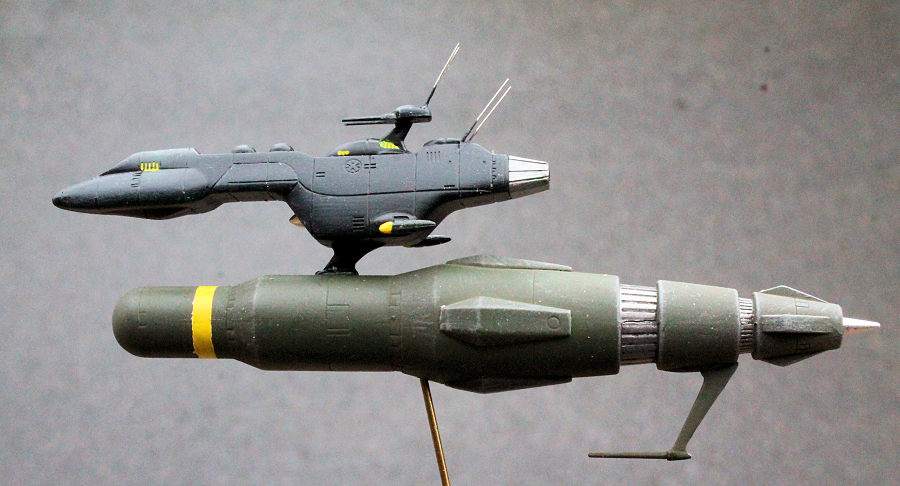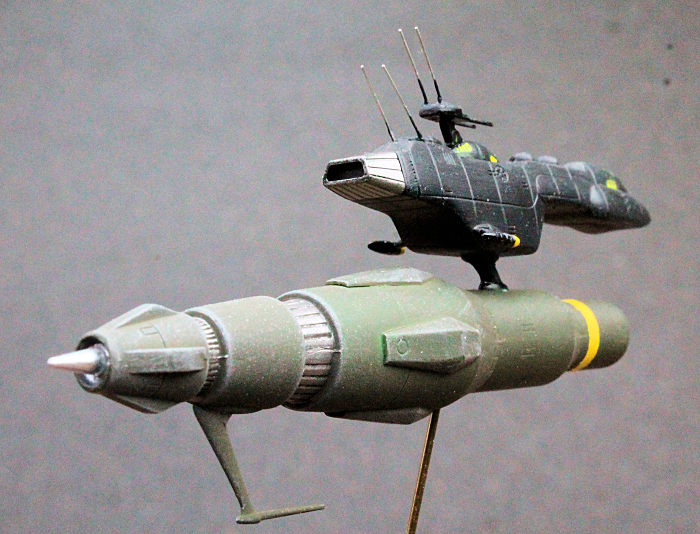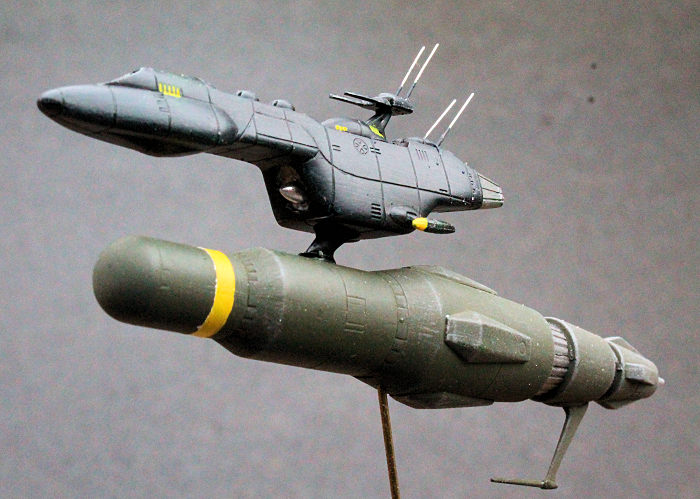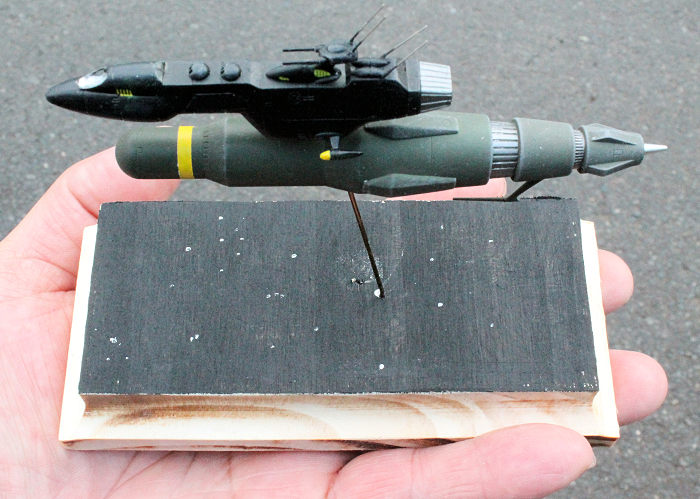
| KIT #: | 0061266-200 |
| PRICE: | 200 yen when new |
| DECALS: | None required |
| REVIEWER: | George Oh |
| NOTES: | A very small kit |

| HISTORY |
In the year 2199, the Earth is attacked by the blue-skinned inhabitants of the dying planet Gamilon, who wish to wipe-out the humans and to take-over the Earth. Their weapon of choice is a stand-off barrage of radioactive meteorites, which renders the surface of the Earth inhabitable, but suitable for the Gamilons.
Earth is offered help from Princess Starsha of the planet Iscandar (Gamilon's sister planet). To get the help, the Humans (raise from the depths of the Pacific Ocean, and) fit the WWII IJN Battleship Yamato with an Iscandar wave-motion engine. They also weaponise the technology to create the Dimensional Wave Motion Explosive Compression Emitter or Wave Motion gun.
 The concept was a Japanese
animation cartoon released in 1974 as "The Space Battleship Yamato", though
'battleship' seems to alternate with 'cruiser'. The series was released in the
USA in 1979 as "Starblazers", and it was produced in three series. It
sparked-off sequels and spin-offs. As well, numerous merchandising items were
produced for the fan market. We modellers were not forgotten.
The concept was a Japanese
animation cartoon released in 1974 as "The Space Battleship Yamato", though
'battleship' seems to alternate with 'cruiser'. The series was released in the
USA in 1979 as "Starblazers", and it was produced in three series. It
sparked-off sequels and spin-offs. As well, numerous merchandising items were
produced for the fan market. We modellers were not forgotten.
In the 1990s, my Wife and I were attending an annual 3-day Model Show & Competition in Melbourne, Australia (Model Expo). On the morning of the third day, Model Expo hosts a Swap n' Sell. As we counted-down the final hour to the prize-giving, a retailer discovered that he had failed to take a carton of assorted Sci-Fi models up to the Swap n' Sell. My Wife looked through the box and asked him what he wanted for several of the kits. Instead, he offered her the whole lot for $150-00 which she accepted - then she tapped me for my unused Swap n' Sell cash. At home, we discovered that this 'instant stash' contained 70+ models from several different Sci-fi universes, in lots of different-sized kit-boxes.
Many of the boxes were the size of my hand, and they contained a bewildering array of spaceships in a variety of sizes and shapes. Several of them tickled my fancy, including this one. Unfortunately, almost all of the boxes have its external (and, I would soon discover, its internal) information in Asian characters that (to my detriment) I am unable to read. The box-art, Sci-Fi friends and the internet was able to fill-in the gaps in my knowledge, and I can only guess at their scales.
This model is listed both as a Proton missile and as a Planet destruction missile. It seems to me, to be a very-large missile, that is carried/pushed/towed by a smaller ship that is mainly a single large engine. Parallels can be drawn from the WWII German Luftwaffe's Me.109/Ju.88 (and other more-fanciful) Mistel combination. In both, the smaller upper machine was manned and attached to the spine of the larger lower machine that is a large self-propelled explosive device, or had been converted into one.
| THE KIT |
This kit came in one of the smaller lid-and-tray boxes that is an big as my hand. The instructions were printed in black on the inside of the box lid. Its three light-green sprues were all packaged in a single plastic bag. The parts were quite crisp with beautifully-petit recessed detail. There were 16 parts to the tug and 8 to the larger missile. Five antennas(?) may be over-scaled due to the limits of the moulding process.
I re-discovered this kit when I was sorting my rather extensive stash while I was in Covid-19 lockdown. I started building it because I was in Covid-19 lockdown, it looked like a quick build, and because its unusual shape still intrigues me.
| CONSTRUCTION & PAINTING |
My plan was to build this model in two sub-assemblies, incorporating a few changes. I'd dump the 2-part kit stand and replace it with a less-obvious one. I'd replace the four straight antenna(?) of the tug ship, with thin(er) wires, and I'd rethink the whole paint scheme.
 The missile I threw
together, except for the tail cone. Fit was so good that I didn't use any filler
on the seams. The missile sits atop a stand that sockets into a rather large
rectangular hole in its belly. Because I didn't like that big artificial hole
(because it detracted from the smooth appearance of the bomb), I excised a piece
from the top of the kit stand and used it to fill the hole. I painted it olive
drab and put a yellow ring around the front so that it resembles a modern slick
bomb. I don't know what the detailed areas are supposed to be, but I painted
them gun-metal for a contrast. To further break-up the plainness of the coat, I
dry-brushed it with light grey. As I had no better information, I painted the
tail-cone bright silver, and the socket it fits in to, black. In this way, I
hope to make it to look like a yet-to-be-lit engine in the tail of the missile.
The missile I threw
together, except for the tail cone. Fit was so good that I didn't use any filler
on the seams. The missile sits atop a stand that sockets into a rather large
rectangular hole in its belly. Because I didn't like that big artificial hole
(because it detracted from the smooth appearance of the bomb), I excised a piece
from the top of the kit stand and used it to fill the hole. I painted it olive
drab and put a yellow ring around the front so that it resembles a modern slick
bomb. I don't know what the detailed areas are supposed to be, but I painted
them gun-metal for a contrast. To further break-up the plainness of the coat, I
dry-brushed it with light grey. As I had no better information, I painted the
tail-cone bright silver, and the socket it fits in to, black. In this way, I
hope to make it to look like a yet-to-be-lit engine in the tail of the missile.
The tug, I view as a warship. I threw it together, too, with the exception of the fine antennas, engine exhaust and intake bullet. Again - fit was pretty good ('cept the 'intake'). It received an overall coat of black because I like to do that to warships in space. A drybrushing of light grey highlighted the angles and detail. The engine bits, and the intake (that does it take-in in space?) received some iteration of silver, for a contrast. The box-art showed yellow windows, so I followed suite by putting a yellow wash into the engraved detail, where I could.
There were no decals for me to use, so I couldn't stuff then up.
The two engine bits were added to the tug, then it was glued to the top of the missile - ensuring that the connecting stem was vertical. The stand is only a brass rod. Its lower end is embedded into a scrap of dressed wood that was painted black, and its upper end bends forward into the tip of the missile. This completed the build.
| CONCLUSIONS |
Not having seen the series, or this ship, I can only speculate how the device worked. It might be a bomb, which is released like a conventional bomb, and attracted by the gravity of the target planet. Or is it released, then propelled to its target by the forward velocity it gains from the speed of the tug - possibly augmented by the engine in the tail, and guided as well? There are bombs with a booster (rocket?) in the tail. There are also guided bombs.
 If it is a missile system,
is the missile carried inside the lower pod (Soviet TOPOL ICBM-carrier style)?
Or was it the cylindrical portion that projects forward as the nose of the lower
pod, the missile (which I could have painted white)? Or is it the whole pod
itself? I went for option 3. I was thinking of mounting the pod in a
just-launched/released position, with the carrier/tug peeling-off from the
missile's trajectory. But I stuck with this simple display instead. And I didn't
follow the colour scheme of the box-art because it didn't appeal to me, or my
military background.
If it is a missile system,
is the missile carried inside the lower pod (Soviet TOPOL ICBM-carrier style)?
Or was it the cylindrical portion that projects forward as the nose of the lower
pod, the missile (which I could have painted white)? Or is it the whole pod
itself? I went for option 3. I was thinking of mounting the pod in a
just-launched/released position, with the carrier/tug peeling-off from the
missile's trajectory. But I stuck with this simple display instead. And I didn't
follow the colour scheme of the box-art because it didn't appeal to me, or my
military background.
This model was a pleasure to build because of the minimal parts, the terrific fit, the minimal requirement for filler, and the fidelity of the detail. It doesn't take-up much room on the shelf, and the modeller can choose to follow or even duplicate, the colour scheme of the boxart, or choose an alternate scheme (as I did). I'm happy to recommend this model (and others like it) to other modellers, though there are those who may disdain it because of its genera or its size (or both). One day, I'll have to get this series on DVD.
Editor's Note. As George mentioned this comes from the series 'Space Battleship Yamato' better know to many as 'Starblazers 2199'. The Proton missile is launched as a whole (the olive part with the yellow stripe) where it then explodes, destroying the planet. For those interested, there has been a 'Starblazers 2202' released which continues the story. As a note of interest, I just finished binge watching all four seasons about a week ago. Each of the series contains 24-25 episodes that were aired on Japanese television in two seasons each. There was even a live action movie, which I've not seen, but apparently wasn't that well done.
George Oh
1 February 2021
Copyright ModelingMadness.com. All rights reserved.
If you would like your product reviewed fairly and fairly quickly, please
contact
the editor or see other details in the
Note to
Contributors.
Back to the Main Page
Back to the Review
Index Page
Back to the Previews Index Page